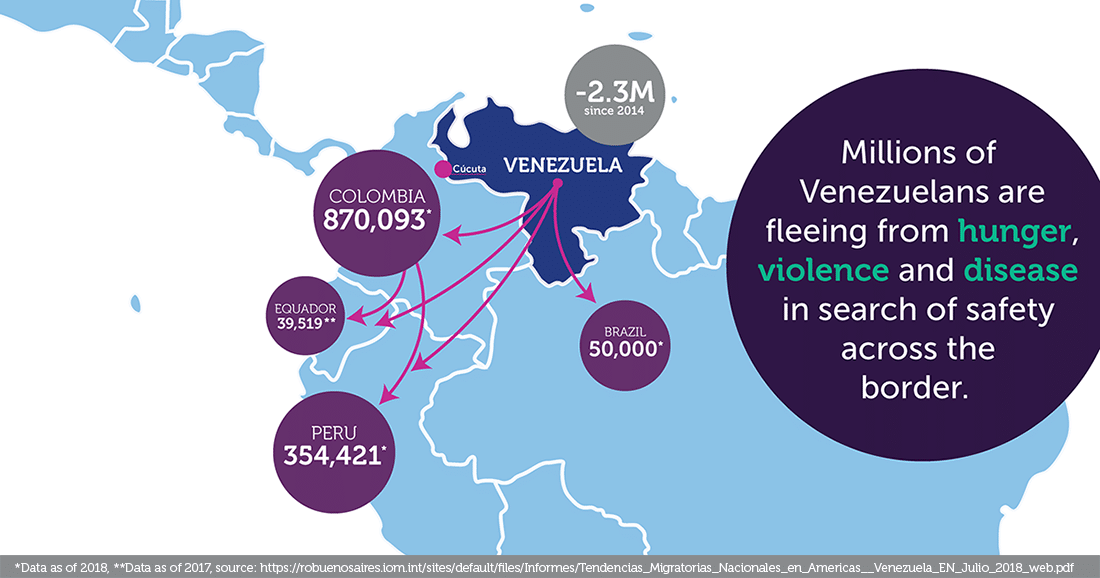
Venezuelan Crisis Update: Situation Worsens as HOPE’s Medical Team Deploys to Colombia
Thousands of displaced Venezuelans are still pouring across the border with Colombia each day, escaping extreme food and medicine shortages and exponential inflation. As Project HOPE continues to scale up its health care service provisions in border regions, our team on the ground reports on how the Colombian health care system is handling this significant spike in patient volume.
“There will be a breaking point very soon…In some hospitals, over 60% of patients are now from Venezuela.”
The Western Hemisphere’s most urgent humanitarian crisis is getting worse.
That’s the takeaway from Project HOPE’s team deployed near the border city of Cúcuta, capital of Colombia’s North Santander department (state). Since 2015, millions of Venezuelans have fled the country to escape drastic inflation and a shortage of basic goods and medical services.
Neighboring countries have been accepting the displaced, but they can only do so much. Health care facilities in Colombia were not designed to support a sudden influx of thousands of new patients.
“There will be a breaking point very soon…it is very evident that they are overstretched,” said Adib Fletcher, a member of the Project HOPE team in Colombia. “In some hospitals, over 60% of patients are now from Venezuela.”
Official estimates from the U.N. report that 2.3 million Venezuelans have left the country in the last few years – but others believe the number to be closer to 4 million. That means anywhere from 7% to 12.5% of the country’s population has left. Imagine if every single person living in Ohio, Georgia, and North Carolina left the U.S. in three years – that’s the scope of the current mass exodus in Venezuela.


Project HOPE’s Frontline Support in Colombia
“It’s impactful to see people walking hundreds of kilometers, often with only their children and whatever they can carry in their hands…many have lost everything and are making a huge sacrifice.”
Project HOPE has been on the ground working to support the overwhelmed health care staff in facilities in and around Cúcuta since September. This month, we deployed four local general practitioners (GPs) to work at two health outposts near the Venezuelan border: La Parada and Santa Barbara.
“On average, 1 GP working half-time is able to see about 16 patients per day…if you look at the numbers, it will mean that an additional 32 consultations will be provided per health outpost per day,” Fletcher explained. “This is significant, because they were turning away between 50 and 60 patients each day.”
For Venezuelans crossing the border into Colombia, these outposts are the first places available for health care services. Patients are treated by workers there whenever possible; those with more serious or complex conditions are referred to local hospitals. Fletcher reports that right now, the Hospital Erasmo Meoz in Cucuta is the only tertiary care hospital providing specialty and emergency services to the entire North Santander department.
By increasing the capacity of the health outposts with more health personnel, we are helping to minimize the corresponding strain on hospitals – like Erasmo Meoz. The more patients treated at these outposts, the fewer patients need to be referred to specialists or seek care through the emergency department at already overburdened hospitals in North Santander.
These measures will make a significant impact, and we are currently in negotiations to add even more support to medical facilities in the area. Project HOPE is optimistic that an agreement to deploy more GPs in North Santander will be reached later this month, allowing them to serve patients in need well into the new year.
“It’s impactful to see people walking hundreds of kilometers, often with only their children and whatever they can carry in their hands…many have lost everything and are making a huge sacrifice,” Fletcher said.
Your generous gift will go directly to our Venezuela response 2018 fund to support our humanitarian efforts to the Venezuela crisis.
Why are Venezuelans leaving?
Although the country has several major ports and is one of the most oil-rich nations in the world, since 2015 the economy of Venezuela has plummeted, in part due to a drop in oil prices. This year alone, inflation is up 285,615%, rendering the Venezuelan bolivar nearly worthless. Basic items like a cup of coffee or a packet of rice now come with a six or seven-figure price tag – if they’re even available. Locals report spending a week or more just to find toilet paper to buy.
The government has raised the minimum wage 3,000% this year alone, and while Venezuela is now included on the UN’s request for relief appropriations, these measures have not yet had much of an impact on the health needs of the displaced. Emergency services and OB/GYN departments in the North Santander department of Colombia are under a particularly heavy load.
“There’s a health crisis, and there’s now a financial crisis within some of these institutions as a result of the increased utilization burden,” said Fletcher. “The hallways [of hospitals] are full of gurneys, because there’s just not enough room to adequately accommodate patients.”
Health care resources are already stretched to their limit – and with substantial aid still seemingly far off, the situation is rapidly heading towards a critical mass.


How you can help
Please help meet the emergency health needs of Venezuelans families with your gift to our Venezuela crisis fund today.